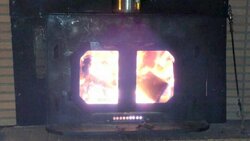Hi everyone, been lurking for a while and thought I'd say hello. The forums are great and have inspired me to create a block off plate and get a flu liner. I recently bought a stove off of Craigs list for $75. I'm going to put a boot on it to hook up the liner.
Anyone know what kind it is? Trying to find optimal flue size. Thinking its going to be 8 or 9 inch. Hoping for 8 can't find 9 inch boots. I measured the inside and the cubic ft came out at 8.6 cubic feet. Then I realized the sides were at an angle, so the cubic feet is probably less. Gotta brush up on my geometry to find volume of trapezoid or find the model of stove to look up
Thanks in advance.
Anyone know what kind it is? Trying to find optimal flue size. Thinking its going to be 8 or 9 inch. Hoping for 8 can't find 9 inch boots. I measured the inside and the cubic ft came out at 8.6 cubic feet. Then I realized the sides were at an angle, so the cubic feet is probably less. Gotta brush up on my geometry to find volume of trapezoid or find the model of stove to look up

Thanks in advance.



